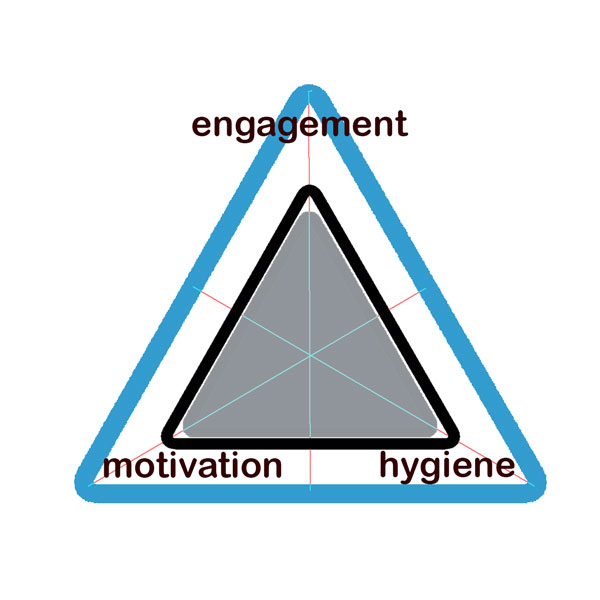The Performance Triangle: Three Factors that Boost Team Potential

In this post, you’ll learn the core differences and similarities between employee engagement, motivation, and job satisfaction. The Performance Triangle offers a powerful visualization of the interplay of factors that impact your team’s performance. By leveraging this model, you can identify the specific areas that need improvement and develop a strategy to achieve excellence.”
By now you should have seen the value of employee engagement, tried the first steps and got the first measurable results that no one can ignore. But why do some organizations perform better? Why is their staff turnover lower and customer reviews higher? If pay and working conditions are comparable, what do they do differently?
Here’s why.
From forced labor – to engagement
When the Pharaoh’s head hunters recruited workers for the Pyramids construction site, they were hardly looking anywhere beyond the candidates’ physical strength and ability to withstand the harsh conditions of the desert. The availability of the right skills and desire to earn money played a secondary role. For fifty centuries, physical factors determined organizational performance.
Only in the twentieth century, the focus has shifted to psychological factors, and eventually to motivation and job satisfaction. They were explained in Abraham Maslow’s Theory of Motivation dating back to the middle of the century, followed by Frederick Herzberg’s two-factor motivation theory (1959).
If you read Maslow in the original and with due attention, you will find Herzberg’s two factors inside the hierarchy of needs, albeit expressed differently. Still, we must credit Herzberg for making work performance two-dimensional. Herzberg argued that job satisfaction and job dissatisfaction affecting employee performance are not simply two ends of the same spectrum, but rather are orthogonal constructs that are related to each other but do not compensate or cancel out each other.
Herzberg coined the terms motivators and hygiene which together constitute job satisfaction. According to his theory, “hygiene” factors in the workplace, such as pay, working conditions, and job security, must be present to prevent job dissatisfaction, but they do not necessarily lead to job satisfaction. In contrast, “motivators” such as recognition, achievement and the work itself are the factors that influence job satisfaction.
Herzberg’s model was easy to understand, and as it sounds pretty convincing, it still serves as the operating foundation for many organizations. However, Herzberg’s model is based almost entirely on two fundamental driving forces underlying all biological life on Earth: survival and pleasure.
But human beings (at least some of us) have evolved. The two-factor view, suitable for explaining the behavior of our distant ancestors, has proved insufficient in the knowledge economy. In 1990, Professor William Kahn of Boston University was the first to bring to light the concept of “personal engagement” as another key factor in work performance.
Although there may be some overlap at the fringes, William Kahn’s conditions associated with personal engagement at work are focused on the emotional and cognitive factors, distinctly different from Frederick Herzberg’s (psychological) motivators and (physical) hygiene. It is important to note that Herzberg’s factors are internal to the job and work environment – and are external to the employee, and engagement is a factor internal to the employee. Thus, engagement constitutes a solid third orthogonal construct that finalizes the three-dimensional model of organizational performance.
The Performance Triangle
The Performance Triangle helps you visualize, monitor, and control the three factors that determine your organization’s performance.
According to the triangular model, organizational performance can be conceptualized as a triangle with three components forming the vertices:

- Physical – workplace hygiene
- Psychological – motivators
- Cognitive – employee engagement
The area of the Triangle represents Performance of the team. Regardless of the performance measurements (or KPIs) your organization prefers, your probable organizational objective will be to increase the area of the triangle by adjusting the components.
Similar to the Iron Triangle in project management, the Performance Triangle helps understand the interaction between the three factors. Although not directly correlated, they are linked in a way that if you change one, you will need to change the other two to maintain performance on the same level.
The ideal Performance Triangle is equilateral. I.e. in an ideal organization (blue triangle), the three components of performance are present at 100%. As nothing is ever “100%” in the real world, the triangle reflecting your organization’s performance will be smaller (grey). The gap between the triangles indicates an improvement opportunity – or wasted potential.
Of course, the Performance Triangles of real companies look different.
Here is a real-life triangle

(that, unfortunately, is characteristic of most organizations today.)
As employee engagement remains often confused with job satisfaction, many organizations have never gone beyond Herzberg’s two-factor model, and continue using only motivators and hygiene factors to drive performance. In reality, the third factor, engagement has always been present, only ignored by the organization, causing a significant performance loss of performance.
In the Knowledge economy, the impact of this third, cognitive factor (red area on the graph) is at least equal to that of the two Herzberg factors (grey triangle). Today, ignoring the role of employee engagement can cost up to one-half of a team’s performance potential, even though the employees report a high level of job satisfaction.
Although the three components of performance are distinct in nature, and controlling them requires different, often independent measures, building your organization’s performance triangle will help you identify performance gaps – and opportunities for improvement. Depending on the type of organization, its culture and maturity, the shape of the triangle and the corresponding performance gaps will differ.
What does your organization’s Performance Triangle look like? Guess how many basic triangles are there?.. Why “best employers” are unionized and why are our civil servants on strike anyway? …
We’ll cover these and other questions in Part 5:The Performance Triangle – Balancing Workplace Hygiene, Motivation, and Engagement.
